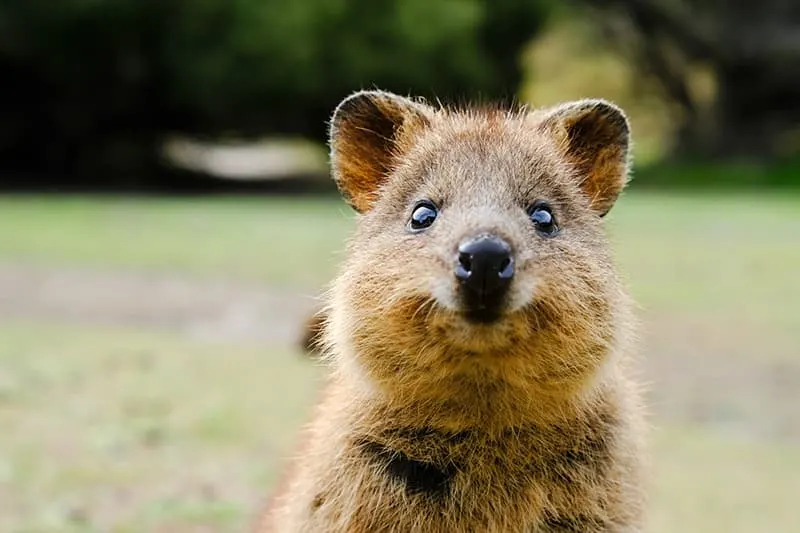Check out all the details about the top 10 friendliest animals in the world! Learn about their description, their habits, and why they're friendly.
Capybara

Capybaras are one of the friendliest animals in the world. Belonging to the Hydrochaeridae family, capybara are the largest rodents in the world. Native to Central and South America, they are mostly found in swampy areas and close to bodies of water. Capybaras can grow as tall as 2 feet and weigh up to 140 pounds (65kg).
They have reddish to dark brown fur and webbed feet. They are excellent swimmers and divers. They eat up to 8 pounds of grass a day and drink a lot of water due to their dry skin.
Capybara live in herd of 10 to 30 members. In the dry season, they may have more than 30 members. The females care for the young. The most dominant capybara is the leader of the herd. The greatest predator of the capybara is the jaguar. Capybara live about 8-10 years in the wild and up to 12 years in captivity.
Dolphins

Dolphins are social, intelligent, and friendly mammals. They can be found in oceans and even some rivers around the world, though they tend to avoid the extreme cold of the Arctic and Antarctica.
There are many species of dolphins, but most are gray in color. One of the most well-known dolphin species is the bottlenose dolphin. They can grow anywhere from 6 to 12 feet long and weigh over 1,000 pounds.
Dolphins breathe through a hole in the top of their head. Their streamlined body lets them swim up to 20 miles per hour.
They eat fish and other marine animals, like squid. They often work together to herd fish into a central location.
Dolphins are very social and playful. A group of dolphins is called a pod which vary in the number of dolphins. Super pods of over 1,000 dolphins have been spotted.
Dolphins communicate with one another primarily through clicks and whistles. The primary predator of the dolphin are large sharks.
On average, dolphins live 15-16 years though they can live up to 40 years in the wild and the oldest dolphin in captivity lived for over 50 years.
Giant Pandas

The black and white giant panda is both cute and friendly. Found in the mountains of Central China, giant pandas can weigh up to 300 pounds (135kg).
They have enlarged wrist bones that act as thumbs for gripping. Giant pandas have broad molars and teeth shaped to help crush the bamboo shoots, leaves and stems that make up the giant panda’s diet.
They are solitary animals, but a female panda will care for its offspring, called cubs, until they can care for themselves, usually at about 18 months old. Giant pandas are excellent swimmers and can climb as high as 13,000 feet. They are considered a national treasure in China.
Full grown giant pandas are too formidable for most predators, but cubs may be preyed upon by jackals, snow leopards, and yellow-throated martens. The average lifespan of the giant panda is 14 and 20 years in the wild and up to 35 years in captivity.
Swans

Swans are considered one of the friendliest birds and are soothed by the human voice. They will, however, fiercely protect their young.
They can be found in temperate climates on both sides of the equator living in flooded grassland, lakes and ponds, rivers and streams, and wetlands.
There are different species of swans, but the largest species can reach almost 5 feet long (1.5 meters), weigh over 33 pounds (15 kg), and have a wingspan over 10 feet (3.1 meters). They are well known for their long, curved neck.
Swans are primarily herbivores, eating aquatic vegetation and plants growing on river beds. However, they are known to occasionally eat small fish, frogs, and worms. A group of swans is called a bevy or a wedge in flight.
Swans mate for life and share all responsibilities with their mate, including incubating their eggs. Thanks to their large size, swans have few predators, but they include wolves, foxes and raccoons which will prey on swans and their eggs. Swans live for an average of 20 to 30 years.
Bearded Dragon

Bearded dragons are one the friendliest reptile species and actually enjoy being handled. They are native to Central and Southern Australia.
The cold-blooded bearded dragon has yellowish, tan skin. It can grow up to 2 feet in length, including its tail which measures more than half of its total length. They can weigh up to 18 ounces.
Bearded dragons are omnivores and enjoy eating insects like cockroaches, crickets and locusts. They also eat flowers, fruit, and leaves. They are solitary animals, only coming together to mate. Predators of bearded dragons include snakes, birds, dingoes, goannas, and crocodiles. Bearded dragons live for about 15 years.
Llama

Llamas are so friendly that they are often used as therapy animals for nursing homes, veterans’ homes, hospitals, and special education facilities. Llamas are native to South America but have been imported to the US and Canada and now number over 100,000.
A full-grown llama usually grows to 5.5 to 6 feet tall and weighs between 280 and 450 pounds. They have long necks, narrow feet, short tails, and long, wooly fur. They can be black, brown, white, or tan.
Llamas are vegetarian and graze on grass. They require a lot of fresh water.
Llamas are herd animals and will fight to move up the social ladder. They spit, ram with their chest, neck wrestle, and kick. Llama babies are called cria, and they stay with their mothers and are weaned at 5 months.
Llamas communicate through humming, clucking, orgling (a sound similar to a person gargling), or a high pitch scream if it needs to alert the herd to danger. Most llamas are domesticated, but natural predators include cougars, mountain lions, and snow leopards. The average life span of a llama is 15-20 years.
Rats

Rats are intelligent, nocturnal mammals that can be found all over the world, but they prefer warm to temperate climates.
Rats are usually between 6 – 8 inches long and 3 -10 ounces in weight. Their hairless tails add another 7 inches in length. They have big ears and long whiskers.
Rat teeth never stop growing, so they chew things to help wear them down. They can have black, brown, gray or white fur. Rats are omnivores that eat almost anything but are quite good at avoiding spoiled food.
Rats are social creatures that live in groups of a dozen or more rats called a mischief. Predators include hawks, owls, and falcons, but domesticated dogs and cats can also prey on rats. Rats have a lifespan of 2-3 years. When raised around people, rats can be friendly and playful.
Parrots

Parrots are very highly intelligent, adaptable and social. Parrots are native to the Southern Hemisphere and can be found in Mexico, Australia, South America and Central America.
There are more than 350 species of birds in the parrot order. Depending on the species, parrots can be anywhere from 3.5 – 40 inches tall and weigh 2.25 – 56 ounces. They often have colorful plumage.
They also have a curved beak, and their feet are zygodactyl which means they have four toes on each foot with two toes pointing forward and two toes pointing backwards.
Parrots are omnivores but seeds are their favorite food. Their strong beak allows them to easily snap nut shells to get to the seed.
Parrots live in groups called flocks, and will often mate for life. The males and females raise their young together.
The most common predators of parrots are raptors (hawks, eagles, owls), snakes, cats (jaguars, ocelots), monkeys and bats. Depending on the species, parrots can live from 5 – 50 years.
Ravens

Ravens can be found all over the world – North America, Eurasia, South America, North Africa, and even in the Arctic regions. They grow to between 22-27 inches tall and weigh 1 to 3.5 pounds. They have a wingspan of 45.5. to 46.5 inches.
They are black with thick necks and shaggy throat feathers. Ravens are omnivores who eat small mammals, nesting birds, eggs, and berries. They are known to use tools to aid in obtaining food and defending their territories.
A group of ravens is called an “unkindness” or “conspiracy.” Ravens often mate for life and share the work of raising their young.
Ravens don’t have many predators but coyotes, large hawks, eagles, owls, martens, and other ravens have been known to go after raven chicks.
In the wild, ravens usually live 10-15 years and in captivity between 40-50 years. Despite the flock’s name of “unkindness,” ravens are known to show empathy to other ravens. And they will respond in a friendly way to birds they remember and like. Ravens are also known to bring shiny objects they find, like soda can tabs, coins, and paperclips, to people who regularly feed them.
Quokkas

Quokkas are marsupials native to Rottnest Island near Perth, Australia. There are a few small groups of quokkas found elsewhere in Australia but the majority are on Rottnest Island.
They are 16-21 inches tall with round, compact bodies covered in short, coarse brown-gray fur. They have round ears and a black nose.
Quokkas can climb trees but prefer living in tall grass near a water source. They are nocturnal herbivores who enjoy leaves, stems and bark, as well as grass. They can survive long periods without food or water by living off the fat stored in their tails.
Quokka babies are called joeys who stay in their mother’s pouch for six months. Their predators include dingoes and birds of prey.
Quokkas have a lifespan of about 10 years. They are so friendly they are known to approach visitors on the island and will even come close enough to take “selfies” with tourists.
What animals do you think are the friendliest?
